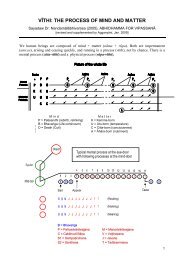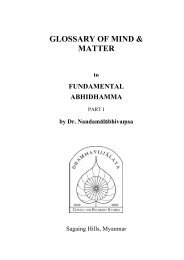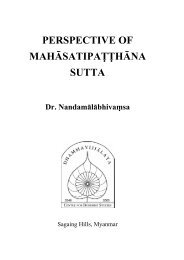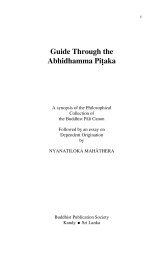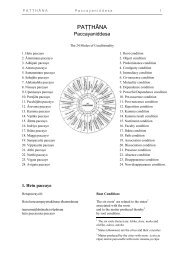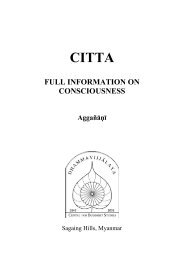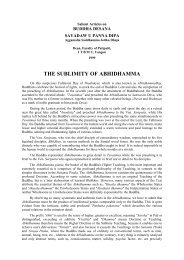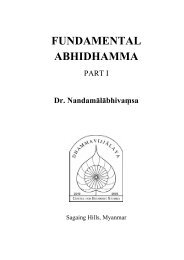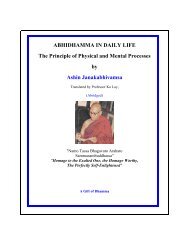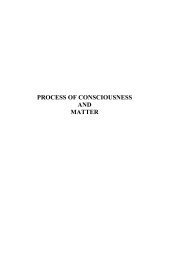Mahathera Ledi Sayadaw - Abhidhamma.com
Mahathera Ledi Sayadaw - Abhidhamma.com
Mahathera Ledi Sayadaw - Abhidhamma.com
Create successful ePaper yourself
Turn your PDF publications into a flip-book with our unique Google optimized e-Paper software.
account of its apparent desire for iron. When it gets near a lump of iron, it shakes itself as though<br />
desiring it. Moreover, it moves itself forward and attaches itself firmly to the iron. In other cases,<br />
it attracts the iron, and so the iron shakes itself, approaches the lodestone, and attaches itself<br />
firmly to it. Here we see the power of the lodestone, which may be taken as a striking<br />
representation of the 'alambana' of mind and the mental factors.<br />
They (mind and its con<strong>com</strong>itants) not only attach themselves to objects, but, at the stage of their<br />
<strong>com</strong>ing into existence within a personal entity, rise and cease every moment, while the objects<br />
remain present at the avenues of the six doors[4]. Thus the rising and ceasing is just like that of<br />
the sound of a gong, which is produced only at each moment we strike its surface, followed by<br />
immediate silence. It is also like that of the sound of a violin, which is produced only while we<br />
strike its strings with the bow over its strings and then immediately ceases.<br />
To a sleeping man--while the life-continua are flowing (in the stream of thought)--kamma, the<br />
sign of kamma and the sign of the destiny awaiting him in the succeeding life--which had<br />
distinctly entered the avenues of the six doors at the time of approaching death in the preceding<br />
existence--are arammana-relations, and are causally related to (the nineteen classes of)<br />
consciousness known as the life- continuum.<br />
End of the Arammana-Relation.<br />
3: Adhipati-Paccaya or the Relation of Dominance<br />
The relation of dominance is of two kinds: the objective dominance and the coexistent dominance.<br />
Of these two, what is the relation of objective dominance Among the objects dealt with in the<br />
section on the Arammana-relation there are some objects which are most agreeable, most lovable,<br />
most pleasing and most regardable. Such objects exhibit the relation of objective dominance. Here<br />
the objects may, naturally, be either agreeable or disagreeable; but by the word 'the most<br />
agreeable objects' only those objects that are most highly esteemed by this or that person are<br />
meant as exhibiting this relation. Excepting the two classes of consciousness rooted in aversion[5]<br />
the two classes of consciousness rooted in ignorance and the tactual consciousness ac<strong>com</strong>panied<br />
by pain, together with the con<strong>com</strong>itants of all these, it may be shown, analytically[6], that all the<br />
remaining classes of Kama- consciousness, Rupa-consciousness, Arupa-consciousness and<br />
Transcendental consciousness, together with all their respective con<strong>com</strong>itants and all the most<br />
agreeable material qualities, are paccaya-dhamma.<br />
Of these, Kama-objects are said to exhibit the causal relation of objective dominance only when<br />
they are highly regarded, otherwise they do not. But those who reach the Jhana stages are never<br />
lacking in high esteem for the sublime Jhanas they have obtained. Ariyan disciples also never fail<br />
in their great regard for the Transcendental Dhammas[7] they have obtained and enjoyed.<br />
What are the things that are related by this relation The eight classes of consciousness rooted in<br />
appetite (lobha), the eight classes of Kamaloka moral consciousness, the four classes of inoperative<br />
Kamaloka consciousness connected with knowledge, and the eight classes of<br />
Transcendental Consciousnes--these are the things related by this relation. Here the sixfold<br />
mundane objects[8] are causally related to the eight classes of consciousness rooted in appetite.<br />
The seventeen classes of mundane moral consciousness are related to the four classes of moral<br />
Kama-consciousness disconnected from knowledge. The first three pairs of the Path and Fruit,<br />
and Nibbana, together with all those classes of mundane moral consciousness, are related to the<br />
four classes of moral Kama-consciousness connected with knowledge. The highest--the fourth<br />
stage of the Path and Fruit of Arahantship--together with Nibbana are related to the four classes of<br />
inoperative Kama-consciousness connected with knowledge. And Nibbana is related to the eight<br />
classes of Transcendental Consciousness.




